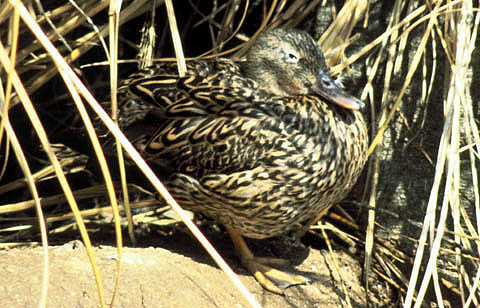Birds and Plants of Kauai:
The Koloa Maoli
by Linda Pascatore on 18 June 2006
The Koloa Maoli, or Hawaiian duck, is a native bird found primarily on Kauai. They are similar to mallards, which may have been their original ancestors, although they are now genetically distinct. The scientific name is Anas wyvilliana. The ducks are mottled brown with green or blue with white borders seen on the spread wings, and a white underwing and orange feet. Males have a darker head, which can be greenish, and are about 19 to 20 inches long, and an olive green
bill. Females have a dull orange or gray bill with a dark saddle, and are about 16 to 17 inches in length. Koloa has a quack like a mallard, but are quieter and less vocal than their mainland cousins.
Koloa Maoli are found in lowland wetlands, river valleys and mountain streams. They often are seen in pairs. They eat shellfish, snails, earthworms, dragonflies and other insects, and a variety of aquatic plants. They nest year round and but usually breed in from December to May, laying two to ten eggs. Their nests are laid on the ground, and are threatened by dogs, cats, and rats. The young can swim right away, but don’t fly for nine weeks after birth.
Kauai is unique in that it still has all the native wetland birds found here before western contact. This is primarily due to the absence of the mongoose. The mongoose was introduced to other Hawaiian islands to combat the rats in the sugarcane fields, and has devastated bird populations on these islands. It is said that when mongoose were originally shipped to Kauai, one of them bit the dockworker who was unloading them. He immediately threw the crate of mongooses
into the bay, thus averting a tragedy for Kauai’s bird population.

The Koloa duck was once found throughout the Hawaiian islands and was mentioned by Captain Cook. The species has become rare on other islands this century. In 1962 the World Wildlife Fund began a restoration project, and now has populations reestablished on Oahu and the Big Island. Kauai was always the stronghold of the species, probably because of it’s high levels of rainfall, large wetland and marshy areas, and large number of slow moving rivers and upland
streams. Before the Mana plain was drained, the count of Koloa ducks there was 400 per square mile. Drainage and development of wetlands and marshy areas has encroached on the native habitat of the duck.
On Kauai, you can see wild populations of Koloa Ducks at the Hanalei National Wetland Refuge, Wailua Reservoir and Wailua Golf Course Pool, Huleia National Wetland Refuge, near Lihue, Menehune Fishpond, Alexander Reservoir near Kalaheo, Mana Wetlands near Barking sands, various upland streams, Koloa Reservoirs, and of course in Koloa Town. The duck is the mascot animal of Koloa Elementary School, and can sometimes be seen near the Koloa River. We also observe the
Koloa duck occasionally in the taro patches of Hanapepe Valley.
|



